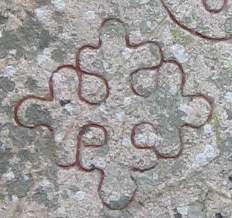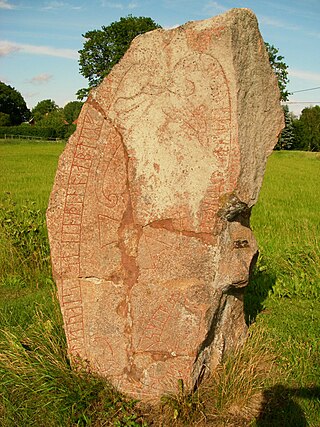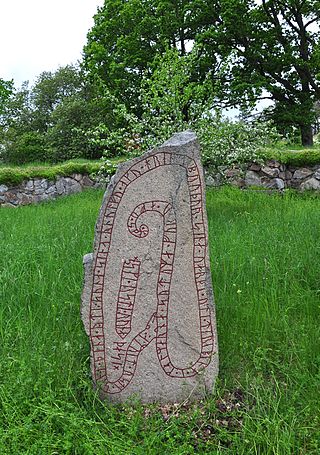The Funbo runestones constitute a group of four runestones originally from Funbo in the province of Uppland, Sweden, which were raised by members of the same family during the eleventh century.

The Eggeby stone, designated as U 69 under the Rundata catalog, is a Viking Age memorial runestone that is located at Eggeby, which is 2 kilometers northwest of Central Sundbyberg, Sweden, which was in the historic province of Uppland.
The Ingvar runestones is the name of around 26 Varangian Runestones that were raised in commemoration of those who died in the Swedish Viking expedition to the Caspian Sea of Ingvar the Far-Travelled.

The Skåäng Runestone, designated as Sö 32 under Rundata, is an Iron Age runestone located in Skåäng, Södermanland, Sweden, which is inscribed in Proto-Norse with the elder futhark. During the Viking Age, a second runic inscription was added in Old Norse using the younger futhark.

The Orkesta Runestones are a set of 11th-century runestones engraved in Old Norse with the Younger Futhark alphabet that are located at the church of Orkesta, northeast of Stockholm in Sweden.

The Lingsberg Runestones are two 11th-century runestones, listed as U 240 and U 241 in the Rundata catalog, and one fragment, U 242, that are engraved in Old Norse using the younger futhark. They are at the Lingsberg farm about 2 kilometres (1.2 mi) east of Vallentuna, which is about 24 kilometres (15 mi) north of the center of Stockholm, Stockholm County, Sweden, which was part of the former province of Uppland.
The Greece runestones are about 30 runestones containing information related to voyages made by Norsemen to the Byzantine Empire. They were made during the Viking Age until about 1100 and were engraved in the Old Norse language with Scandinavian runes. All the stones have been found in modern-day Sweden, the majority in Uppland and Södermanland. Most were inscribed in memory of members of the Varangian Guard who never returned home, but a few inscriptions mention men who returned with wealth, and a boulder in Ed was engraved on the orders of a former officer of the Guard.

The Risbyle Runestones are two runestones found near the western shore of Lake Vallentunasjön in Uppland, Sweden, dating from the Viking Age.
The England runestones are a group of about 30 runestones in Scandinavia which refer to Viking Age voyages to England. They constitute one of the largest groups of runestones that mention voyages to other countries, and they are comparable in number only to the approximately 30 Greece Runestones and the 26 Ingvar Runestones, of which the latter refer to a Viking expedition to the Caspian Sea region. They were engraved in Old Norse with the Younger Futhark.

The Varangian Runestones are runestones in Scandinavia that mention voyages to the East or the Eastern route, or to more specific eastern locations such as Garðaríki in Eastern Europe.
The Viking runestones are runestones that mention Scandinavians who participated in Viking expeditions. This article treats the runestone that refer to people who took part in voyages abroad, in western Europe, and stones that mention men who were Viking warriors and/or died while travelling in the West. However, it is likely that all of them do not mention men who took part in pillaging. The inscriptions were all engraved in Old Norse with the Younger Futhark. The runestones are unevenly distributed in Scandinavia: Denmark has 250 runestones, Norway has 50 while Iceland has none. Sweden has as many as between 1,700 and 2,500 depending on definition. The Swedish district of Uppland has the highest concentration with as many as 1,196 inscriptions in stone, whereas Södermanland is second with 391.
The Baltic area runestones are Viking runestones in memory of men who took part in peaceful or warlike expeditions across the Baltic Sea, where Finland and the Baltic states are presently located.

Södermanland Runic Inscription 84 or Sö 84 is the Rundata designation for a runic inscription on a Viking Age memorial runestone located in Tumbo, Södermanland County, Sweden, and in the historic province of Södermanland.

The Holmfast Inscriptions are two Viking Age memorial runic inscriptions and one image that are designated as Sö 311, Sö 312, and Sö 313 in the Rundata catalog. They are located in Södertälje, Stockholm County and the province of Södermanland, Sweden by the eponymous road Holmfastvägen.

The Bjälbo runestones are three Viking Age memorial runestones, one of which has been lost, located at Bjälbo, which is a village in Mjölby Municipality, Östergötland, Sweden. One of the inscriptions provides evidence of the existence of guilds in Sweden during this period.

Uppland Runic Inscription 1145, or U 1145 in the Rundata catalog, is a Viking Age memorial runestone that is located near the town of Tierp in Uppland, Sweden.

Uppland Runic Inscription 130 or U 130 is the Rundata catalog listing for a Viking Age memorial runic inscription which is located at Nora, which is in Danderyd, Stockholm County, Sweden, and in the historic province of Uppland. The runic text directly refers to an estate held in an allodial title.

The Fuglie stone 1 or DR 259 is a Viking Age runestone engraved in Old Norse with the Younger Futhark runic alphabet. It was first mentioned by Skonvig and it is still located in its original location on a Nordic Bronze Age mound next to the church of Fuglie, Skåne, Sweden. There are many local legends and traditions about the stone. The stone is 105 cm tall, 63 cm wide, and 33 cm thick. The stone is dated to the period 970–1020, and the style of the runestone was the runestone style RAK.

The Södermanland Runic Inscription 333 is a Viking Age runestone engraved in Old Norse with the Younger Futhark runic alphabet. It is located at the abandoned Ärja Church in Strängnäs Municipality. The style of the runestone is a categorized as Fp.
The Uppland Runic Inscription 954 is a Viking Age runestone engraved in Old Norse with the Younger Futhark runic alphabet. It was found by Johannes Bureus, but it has disappeared. It was located near Danmark Church in Uppsala Municipality. The style is possibly Pr1.













